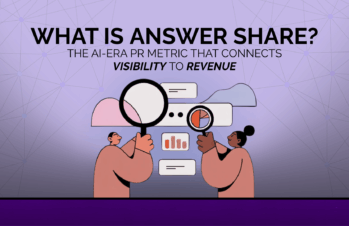Public relations (PR) in the B2B world can be an afterthought for marketers. Often, the joke is “PR stands for press release, right?” But B2Bs with that mentality risk losing out on the enormous benefits of PR—like increased credibility, trust, social media engagement, and SEO benefits.
That means, if you’re not leveraging PR efforts, you’re missing out on media impressions, website traffic, and business growth.
In fact, 9 in 10 decision-makers and C-suite executives say they are moderately or very likely to be more receptive to sales or marketing outreach from a company that consistently produces high-quality thought leadership, and nearly 75% that thought leadership content is a more trustworthy basis for assessing an organization’s capabilities and competencies than its marketing materials. But what does thought leadership have to do with PR?
Everything.
PR efforts should be at the forefront of every B2B marketer’s mind, as public relations are a crucial (dare we say fundamental) element of modern digital marketing. Why? Well, what will potential customers and decision makers find when they search for your brand on Google and social media? Exclusively owned media (content your brand creates) and a handful of social media followers is not enough. Today, business success requires social proof leveraging owned and earned media, illustrating that your brand not only has expertise to share but also has the credibility to be recognized by industry publications.
You can be sure that the “big guys” your company is competing with—and whose market share you’re trying to chip away at—have invested in a robust PR program spearheaded by a trusted PR firm. So if you haven’t launched your own PR program as part of your digital marketing, consider this your sign to start.
Related reading: The Four Types of Media: Rented, Owned, Paid, Earned
How PR Efforts Amplify and Demonstrate Thought Leadership
Effective PR campaigns transform thought leadership from social media posts and content creation into verifiable industry influence. When PR strategy and thought leadership work together, your expertise reaches your target audience through strategic channels:
PR Media Coverage: Article Promotion and Placement
PR professionals actively pitch bylined articles to relevant industry publications, trade journals, and business media. They leverage relationships with editors and journalists to secure placements that position your executives as authorities. This extends beyond company blogs to third-party publications that your target audience already trusts and reads regularly.
Executive Interview Opportunities Through PR Initiatives
PR teams identify and secure speaking opportunities, podcast appearances, and media interviews for company leaders, ensuring that those opportunities align with a company’s business goals. A professional PR team will prepare executives with media training, talking points, and anticipatory Q&A sessions to ensure thought leaders communicate key messages effectively while appearing authentic and knowledgeable.
Content Amplification Strategies from PR Efforts
Beyond creation, PR ensures your thought leadership reaches maximum audience through:
- Strategic social media promotion across platforms where your audience engages
- Email campaigns to industry influencers and media contacts
- Repurposing content into different formats (infographics, videos, podcasts)
- Tracking media mentions and leveraging them for additional visibility
Building Media Relationships Through PR Campaigns
Successful PR efforts involve cultivating ongoing relationships with journalists and editors who cover your industry. These connections lead to reporters reaching out to your experts when they need quotes or insights for stories, creating organic media mentions that build credibility.
PR Campaigns Are Digital Marketing
A combination of elements like these make for robust PR campaigns that can help drive business growth and differentiate you from your competitors. But how do PR companies and marketing agencies measure a PR campaign’s success? This is a crucial question because, naturally, executives and decision-makers will want to know how to measure any PR campaign’s impact on their business.
In fact, one of the biggest challenges surrounding PR campaigns is finding the right mix of metrics to show a tangible business impact. Your CFO will give you a pat on the back for your CEO’s snappy quote in a business journal, sure. But at the end of the day, that same CFO will want to know how to measure PR success so they can see what their PR investments look like for the company’s bottom line.
Related Reading: The Ultimate Guide to B2B PR
How to Measure PR ROI

Google Analytics can only get you so far—so we’ll cut right to the chase: One of the best ways to measure PR is to invest in a trusted PR company. At Zen Media, for example, our experienced PR team knows how to create, manage, and measure PR campaigns that move the needle across a variety of tangible metrics. We leverage state-of-the-art media monitoring tools to track web traffic, content marketing effectiveness, organic search traffic, and other key performance indicators to ensure clients know their PR investments are paying off.
And professional marketing agencies will tell you: no two PR campaigns are alike because no two businesses are the same. Even if a PR firm is working with, say, two B2B robotics companies, their content marketing efforts and tech PR won’t (and shouldn’t) be the same. With that in mind, at Zen, we have a customized framework that identifies quantifiable metrics—along with the qualitative aspects of PR—to give clients clarity about how PR works and how to track its success. This arms our clients with the business argument when asked, “What is our PR doing for us?” The answer: a lot.
That said, you can use the following framework to track the effectiveness of your public relations efforts, even if you haven’t engaged a professional PR firm.
How to Measure PR: Quantitative Analysis

Oftentimes, PR depends on timing. The newsworthiness of topics, reporter availability, breaking news, and the ability of your spokespeople to be available and provide expertise can impact not just when your stories hit the news but your PR outcomes in general.
At Zen Media, our PR measurements involve quantifying all PR efforts on a weekly and a monthly basis to ensure that all activity is captured, including:
- Media Pitches
- Interviews
- Press Releases
- Podcasts
- Contributed Articles
On top of that activity, we dive deeper into what that activity has provided.
Understanding what your press hits, podcast appearances, and contributed articles provide is key to understanding its value and calculating ROI.
It’s important to pick the metrics most relevant to your brand. For instance, if your brand is relatively unknown and/or has never had “bad press,” sentiment may not be an important metric to track. If that’s the case, you can skip sentiment in favor of something that is relevant to your business—such as share of voice. There are plenty of measurements that help illustrate the results that earned media bring—the question is, which of these measurements matter to your brand?
- AVE (ad equivalency value)
- Domain Authority (the strength of the websites where your earned media appears)
- Search Engine Ranking
- AI Suggestions and References (ChatGPT, Perplexity, and similar)
- Share of Voice
- Social Media Mentions
- Sentiment (positive or negative)
- Engagements (what’s the social media interest in your story)
- Pieces of Earned Media Coverage (volume count)
- Journalist Reach
- UVMs (visitors to the websites where your business is included)
As part of our media relations and marketing programs, Zen Media also helps to identify and secure award submissions, potential speaking engagements, social media amplification, and more to further build brand awareness and credibility.
Related reading: Understanding the Differences between REO and SEO
How to Measure PR: Qualitative Analysis
In addition to the above metrics, it’s important for marketers to take into consideration what is impacting your earned media performance:
- What are your competitors talking about, and where should you be positioned in that conversation?
- Were there instances where media opportunities were missed due to an executive who couldn’t turn around an interview in time?
- What do we think is coming down the pike, and what can we get ahead of before our competitors?
The last piece of the puzzle is the tangential results that come with an increased media presence. While the lines may not be parallel, an increase in earned media will likely show a similar trajectory in:
Branded search increase: Through tools like SEMRush and Google Search Console, marketers can measure the impact of PR on brand-related searches. This will result in gaining more share of search and share of voice.
SEO benefits: PR, if done correctly, will positively impact your SEO. Over time your domain authority will increase, which helps your site rank for more keywords and continues to establish your website as authoritative in the eyes of search engines like Google. Often, PR from one publication is picked up by other syndication sites, spreading your message and positively impacting your overall SEO and rankings—especially if the original press contains a link to your website. The more websites link to your site, the better your site ranking will be and the more traffic you’ll generate.
Sales-enabled PR shortens the sales cycle: Sales-enabled PR creates demand, nurtures leads, and drives revenue by intertwining PR throughout the entire sales cycle.
How? Prospects go through dozens of touchpoints before they convert—in fact, this process can last almost a year. At the same time, we also know that B2B buyers spend 70% of their journey doing independent research online and talking with peers before they ever bother to talk to a salesperson. In fact, many prospects make their decision before a company is even aware they exist, as 81% of B2B buyers have picked their solution of choice before ever reaching out to a sales rep.
Related Reading: How PR Shortens the Sales Cycle
From this data, we know two things:
- The faster your client can make those touchpoints, the faster they will move down the sales funnel, shortening the sales cycle.
- The more credibility, trust, and informative content you can put in front of prospects, the more likely they will independently choose to buy from your brand.
PR accomplishes both of these goals:
Goal 1: Speeding up touchpoints
Through consistent media coverage, your brand will have many opportunities to make touchpoints with its audience. As this coverage sparks interest, your audience will be more apt to explore your brand, meaning they will search for your brand by name or for topics related to your brand. Because PR helps boost SEO, your prospects’ searches will direct them to your owned media where they can make many more valuable touchpoints. Plus, by using social media amplification, marketers expand the reach and life of each press hit, enabling many more touchpoints.
Goal 2: Building credibility
Strong media coverage in reputable industry publications, top-tier press, industry-specific podcasts, and more will help create frequency bias, wherein your audience is more inclined to notice your brand and seek it out. Plus—due to human nature—the more familiar your brand becomes, the more likely people will be compelled to trust it.
On top of this, third-party validation is a huge driver of credibility—we all believe an impartial journalist more than a brand’s own advertising.
How to Measure PR Impact
Modern PR integrates with marketing analytics to track the ROI of thought leadership initiatives through metrics like media impressions, website traffic from media placements, social sharing, lead generation attributed to thought leadership, and changes in brand perception.
By integrating PR strategies with your thought leadership program, you transform expert insights into tangible business advantages that drive credibility, visibility, and ultimately, revenue growth.
How Long Does It Take for PR to Make an Impact?
So you’ve determined what matters to your brand, and you’ve begun your PR efforts—either internally with a PR professional on your team or by outsourcing to an agency.
When will you start seeing measurable results?
Many PR agencies claim that public relations takes roughly a year for measurable results. This is largely because traditional PR stops at getting press hits. They pitch to the media, get a hit, your brand gets a flurry of attention, and then that attention dies out, and the process begins again. With traditional PR, a year is a reasonable timeline to see measurable growth in SOV, sentiment, domain authority, and more.
But we don’t practice traditional PR at Zen Media. We use a sales-enabled PR model that leverages all the strengths of traditional PR, along with digital pathways and a growth-oriented mindset to help each press hit last longer and reach further. Our common PR contracts are only 6 months—though many of our clients stay with us much longer—because sales-enabled PR works much faster and makes a larger impact.
Essentially, sales-enabled PR takes less time and gets better results.
How to (Effectively) Measure PR Outcomes
While we know trying to measure anything and everything is a fruitless endeavor, certain metrics must be kept. (After all, the C-suite needs data to back spending and decision-making.)
After a big press hit, you will have increased impressions and engagement on social media. You may even have higher rates of branded search. These are easy to measure, and while they may not 100% reflect return on ad spend—at least not at first—what they are is a clear indicator that eyes on your earned media compelled people to search for your company on social or Google.
If you adjust your strategy and see a parallel increase in engagement, search returns, conversions, etc., you can reasonably assume that whatever new component you introduced (a new PR strategy, new paid ads campaigns, a new social account) has caused the spike. You may not be able to prove that the spike is due to the new marketing strategy or component, but with consistently tracked data, rotating the timing and authority of press hits, and committing to a long-term vision, you can begin to understand how PR impacts awareness.
After a few months of executing a comprehensive sales-enabled PR strategy, you will have plenty of data to analyze; that’s why we track quantifiable metrics monthly and qualitative metrics quarterly.
By using our comprehensive PR ROI Framework, you have the ability to answer your company’s decision-makers—both in words and in data when they ask, “What is the point of PR?” But we know PR campaigns are a lot to handle—and you have a business to run. So, if you want to see the real-world impact and measurable ROI a professional team of genuine PR experts can bring to your brand, let’s talk.




